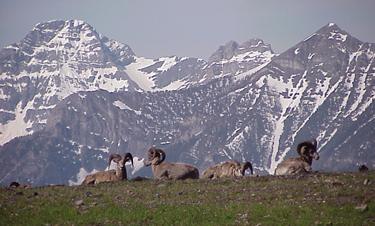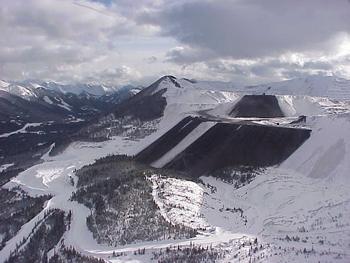|
Introduction
A
Closer Look: The Elk Valley
Taking
Care of the Environment: Greenhills
Air
Quality Control
Water
Quality and Drainage Control
Testing
Water Quality
Reclamation
of Post-Mining Areas
Why
Do Research?
Conclusion
|
A Closer Look:
The Elk Valley
Let's look at
the coal mines in the Elk Valley, in the
southeastern corner of BC.
When plans to mine coal in this area
became public in the late 1960’s, little was known about
surface mine reclamation in this mountainous terrain. Important
environmental issues were raised by the concerned public. The
need to develop cost-effective measures to stabilize waste dumps,
protect local watercourses and restore the forest resource and
critical wildlife habitat was evident. The mines were committed
to meet the challenge and have. Research has been conducted for
over 30 years and has made a substantial contribution to the development
of mine reclamation technology in British Columbia. The technology
developed here is successfully applied at the mines where waste dumps and disturbed
land are restored to productive commercial forest and wildlife
habitat.

"Mountain Sheep on Hilltop"
Concerns
facing the mining industry
Mining
produces a lot of waste rock:
- The five
Elk Valley coal mines produce 15 million tonnes of coal every
year and from five to ten times as much waste rock. For example,
for some mines with a strip ratio of 5:1, this means they
would have to take out five times as much waste rock for every
million tonnes of coal they produce.
Changing
the way the land looks:
- Open-pit
mining cuts into the tops of mountains to get to the coal.
Coal seams are then followed and cut deeper and deeper into
the hillside until the mountain slowly changes shape. While
mining disturbs the land temporarily, reclamation turns
the land back into productive forests and wildlife ranges. Years
of extensive reclamation research provide the tools to do
the job effectively.

"Benches at the mine during winter"
Mining restores
wildlife habitat:
- The Elk
Valley is home to many large animals including elk, moose,
white tail deer and bighorn sheep. While elk are the most
abundant, the lack of winter range is the limiting factor
for elk population. Early research efforts focused
on providing good quality winter range through reclamation.
The mines now boast huge numbers of elk that have made these
reclamation areas prime breeding ground. The mines also help support
a very important grizzly and black bear population.
Waste Rock
and Tailings Management:1
- At the
mine site, a major environmental challenge involves the management
and treatment of waste and effluent from the mining process.
While waste rock is stored at designated sites to be reclaimed,
coal is sent to the plant for processing. The waste from this
process is called tailings. This slurry is pumped to a tailings
pond, contained by dams and/or other carefully engineered
structures. Effluent from a tailings pond is recycled to the
plant or is treated to remove contaminants before the water
is discharged into the local environment. The management and
control of tailings, both during and after mining, is a prime
responsibility of a mining company.

"A Bird's Eye View of Fording Falls"
Pollution
vs. Emissions:
- Pollution
and emissions are different things and they should not be
confused. Pollution implies that something is negatively affected;
we commonly use the term to mean that the environment has
been harmed by man’s activity. Emissions, on the other
hand, are materials released in the form of air or dust, liquid
or solid waste which do not necessarily affect the environment
unfavourably. Emissions can be benign, such as the release
of treated water. Emissions from the mining process include
waste rock and tailings, as well as effluent (liquid emissions).
Managing these emissions is a priority for all mining companies.
Laws governing the mining industry demand stringent operating
guidelines in all aspects of emission management. As a result,
mining emissions are prevented from becoming pollution generators.
Next
Page
|



